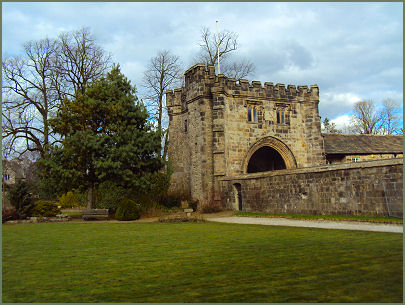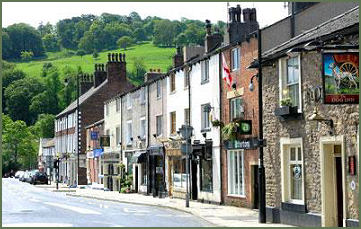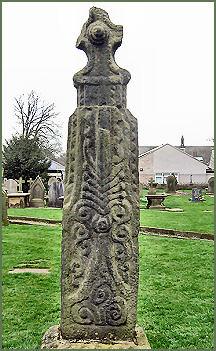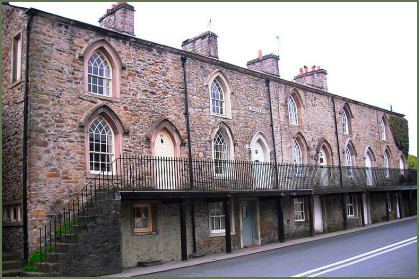Whalley
OS Grid ref:-SD735365
 Whalley a large, historic village is located to the south of Clitheroe, in Lancashire's beautiful Ribble Valley.the village is overlooked by the wooded hill of Whalley Nab which rises to 607 feet and lies on the River Calder.
Whalley a large, historic village is located to the south of Clitheroe, in Lancashire's beautiful Ribble Valley.the village is overlooked by the wooded hill of Whalley Nab which rises to 607 feet and lies on the River Calder.
Recorded in the Domesday Book of 1086 as 'Wallei', when it was owned by Roger of Poitou. The name means the Field of Wellsí, from the Anglo-Saxon ëWell Leaí.
Whalley Abbey (gatehouse pictured left) is set on the banks of the river, it was founded by Henry de Lacy, third Earl of Lincoln on the 4th April 1296. It was occupied by Cistercian monks from Stanlow Abbey, who were suffering flooding from the River Mersey during the latter part of the thirteenth century. The first stone of the new building was laid by Henry de Lacy in June of 1296.
Only the foundations of the church remain. The remains of the former monastic buildings are more extensive. The west range, which was the lay brothers' dormitory, consists of two stories, and is roofed. To the south of the cloister, part of the walls of the former kitchen and refectory remain. The east range is more complete and includes parts of the walls of the former monks' day room, parlour and vestry.
 The abbey closed in 1537 as part of the dissolution of the monasteries. Its abbot, Abbot Paslew was tried at Lancaster and executed for high treason in Whalley on the 10th March 1537 for taking part the Pilgrimage of Grace, a northern rebellion against King Henry VIII, which had taken place in the previous year.
The abbey closed in 1537 as part of the dissolution of the monasteries. Its abbot, Abbot Paslew was tried at Lancaster and executed for high treason in Whalley on the 10th March 1537 for taking part the Pilgrimage of Grace, a northern rebellion against King Henry VIII, which had taken place in the previous year.
Whalley Viaduct, a 48-span railway bridge crossing the River Calder was built between 1846 and 1850 under the engineering supervison of Terrence Wolfe Flanagan. It is the longest and largest railway viaduct in Lancashire. Known locally as Whalley Arches, it consists of 29 brick arches of 9 metres (30 feet) and 20 arches of 12 metres (40 feet), it took three years to complete at a cost of £40,000.
The village church of St Mary and All Saints was founded in 628, in the period when St. Paulinus, made Archbishop of York in the year 627, is alleged to have preached and baptised at Whalley. The present church was built sometime after the beginning of the thirteenth century. The tower dates from 1440. The interesting church is included in Simon Jenkinsí book ĎEnglandís Thousand Best Churchesí.
 One of the most striking features is the oak roof embellished with beautifully carved bosses. The chancel is attributed to Petrus de Cestria who was Rector from 1235 to 1295. The east window displays the armorial bearings of many old Lancashire families connected with the church.
One of the most striking features is the oak roof embellished with beautifully carved bosses. The chancel is attributed to Petrus de Cestria who was Rector from 1235 to 1295. The east window displays the armorial bearings of many old Lancashire families connected with the church.
The church has a large number of notable misericords, eighteen of which date from the fifteenth century, which came from Whalley Abbey, they were moved to the church when the abbey was dissolved. There are also four dating from the Victorian period. The south side of the chancel has a priest’s door dating from the thirteenth century which still retains the original ironwork and bronze head knocker.
 A Roman altar-stone, dating from the third to fourth century is situated in the north aisle, next to the churchwardens' pew. A carved figure on the stone depicts what is probably Mars, the Roman god of war. It was discovered in the churchyard in 1440.
A Roman altar-stone, dating from the third to fourth century is situated in the north aisle, next to the churchwardens' pew. A carved figure on the stone depicts what is probably Mars, the Roman god of war. It was discovered in the churchyard in 1440.
Embedded into the inner archway of the north doorway is an inscribed stone, with Latin inscription, dating from 270 AD. There is also a fifteenth century chancel screen and a medieval pew. In the churchyard stand three Anglo-Saxon crosses, the oldest dating from the tenth century (pictured left).
The River Calder has a man-made weir section at Whalley, said to have been constructed to allow the monks of Whalley Abbey to collect water easily. The weir was built to guide water to a channel, that fed a water wheel in the Corn Mill. The power to the Mill was all belt driven through a pulley system. The Mill has now been transformed into condominiums.
Whalley has a good range of shops and four pubs - The Dog, The Whalley Arms, The Swan Hotel (established in 1780) and The DeLacy Arms. The author Harrison Ainsworth, stayed at Bridge Cottage in Whalley while researching his famous novel 'The Lancashire Witches'.
Whalley Pickwick Night (named after the Charles Dickens novel The Pickwick Papers) is an annual event in the village it takes place in December, with people in Victorian costume to raise funds for charity.
Nearby Places of Interest
Whalley Abbey- founded by Henry de Lacy, third Earl of Lincoln on the 4th April 1296.
Lancaster Castle founded in the tenth century
Ashton Memorial in Williamson Park, Lancaster was commissioned by James Williamson, Baron Ashton as a tribute to his second wife, Jenny and was built between 1907 and 1909.
Butterfly House, Lancaster
Clitheroe Castle-Norman castle keep and museum, said to be one of the oldest buildings in Lancashire, and one of the smallest keeps in England.
